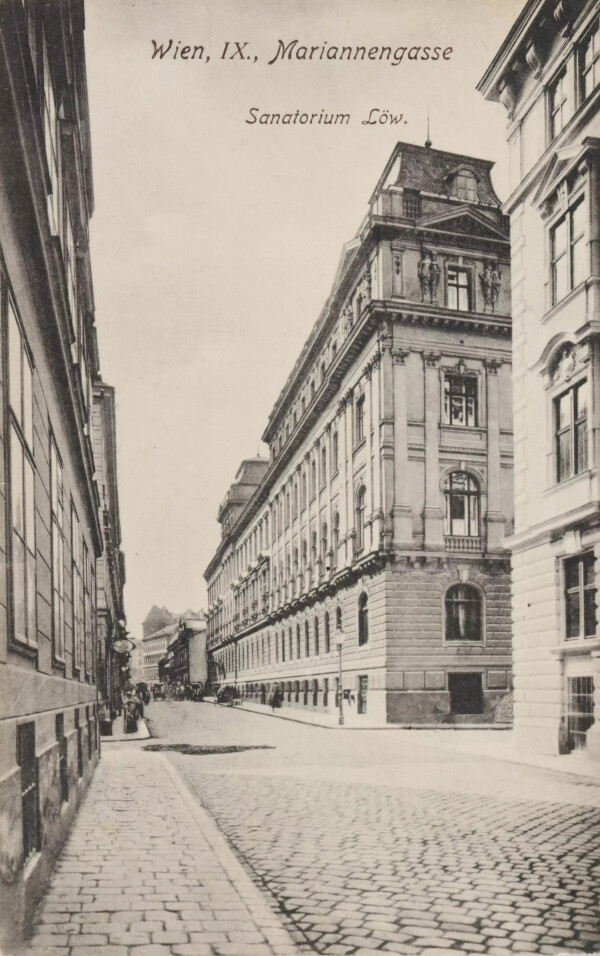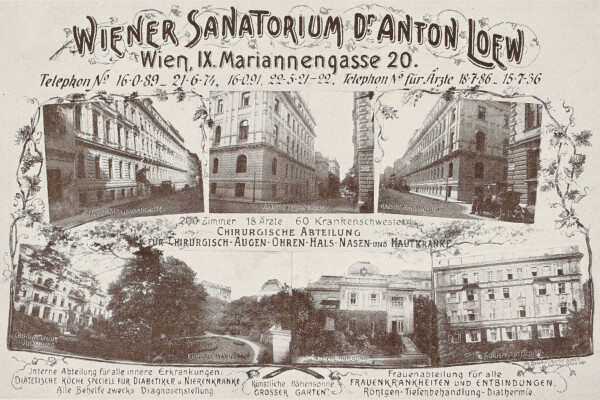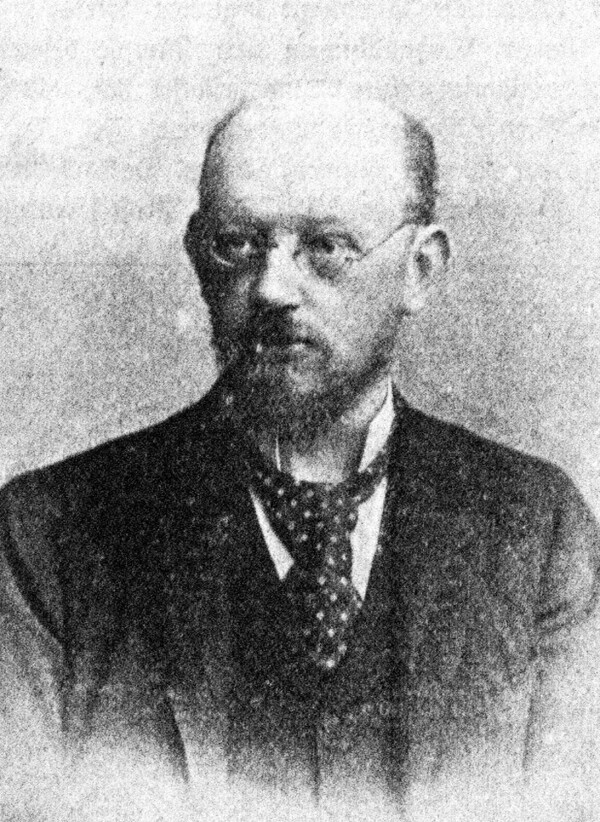The Loew Family

Picture postcard of the Loew Sanatorium at Mariannengasse 20, 1906/07
© Wien Museum

Postcard advertising the Vienna Sanatorium Dr. Anton Loew. Josef Gerstmayer book and art printing company, Vienna, 1910-1925
© Josephinum - Ethik, Sammlungen und Geschichte der Medizin, MedUni Wien

Gustav Klimt: Portrait of Gertrud Loew, 1902, The Lewis Collection, in: Kunstverlag Hugo Heller (Hg.): Das Werk von Gustav Klimt, Vienna - Leipzig 1918.
© Klimt Foundation, Vienna

Anton Loew, in: Wiener Bilder. Illustrirtes Familienblatt, 18.09.1907.
© ANNO | Austrian National Library
The wealthy Loew family, known primarily for the renowned Sanatorium Dr. Anton Loew, were important supporters of Viennese Modernism, and tasked Gustav Klimt and Kolo Moser with special commissions.
The Loew Family
The physician Dr. Anton Viktor Loew, who was born on 20 October 1847 in Pressburg (now: Bratislava), married Sophie Franziska (née Unger), born on 22 December 1854. Along with several children who did not live past childhood, the couple had daughter Gertrud “Gerta” Franziska Sophie Loew, born on 16 November 1883. The year of her birth, the Jewish family converted to the Roman-Catholic faith.
Anton Loew was a passionate art collector and an important early benefactor of the Vienna Secession, as we can infer from Alfred Roller’s first membership list.
The Sanatorium Dr. Anton Loew
The physician headed Sanatorium Loew (from 1882 at Mariannengasse 18–20, Vienna-Alsergrund, 9th District) founded by his father, which was not only one of the noblest but also among the largest private hospitals in Vienna around 1900. From 1906, the premises were extended with a highly progressive women’s sanatorium at Pelikangasse 13–15. The family lived in close proximity, at Pelikangasse 7.
The patients at Sanatorium Loew included members of the nobility and the imperial family, as well as notable artists. Archduchess Elisabeth Marie Windisch-Grätz, the daughter of Crown Prince Rudolf, had her appendix removed at the clinic. Ludwig Wittgenstein, Gustav Klimt, Alma Mahler-Werfel and Gustav Mahler also visited the hospital. The composer died there in 1911.
Along with heading this institution, Anton Loew and the psychiatrist Richard Krafft-Ebing also founded a sanatorium in Purkersdorf near Vienna in the late 19th century, which in 1903 was sold to the industrialist Victor Zuckerkandl. The latter, in turn, commissioned Josef Hoffmann with the reconception of the infirmary, which would become known as Sanatorium Purkersdorf.
The Loew Family and Gustav Klimt
The acquaintance between Gustav Klimt and Anton Loew was not only owed to the doctor’s role as a benefactor of the Secession but likely also to the artist’s stay at the sanatorium. Portrait studies from the late 1890s – which presumably show Sophie Loew – are testament to this association. In 1902, Klimt was commissioned to paint the work Portrait of Gertrud Loew (1902, The Lewis Collection, USA). This portrait of Loew’s then 19-year-old daughter, whose colors were lauded by Ludwig Hevesi as boasting “the finest lyricism the palette is capable of,” could have been intended either as a birthday gift for the father, or as a present for the soon-to-be married couple Gertrud and Johann Arthur Eisler von Terramare. One of the first to be able to view this new creation in a private setting was Hermann Bahr. In 1903, after a visit with the Loew family, he wrote in his diary:
“[…] Klimt has now painted his daughter, in white with violet hues, so wonderfully floating and delicate that it might bring you to tears.”
Upon its completion, the portrait was shown in 1903 in the “XVIII. Ausstellung der Vereinigung bildender Künstler Österreichs Secession Wien. Kollektiv-Ausstellung Gustav Klimt” [“18th Exhibition of the Union of Austrian Artists Vienna Secession. Gustav Klimt Collective Exhibition”] together with Judith I (1901, Belvedere, Vienna), which was also an integral part of the Loew’s Klimt collection. The exhibition further featured a drawing. On 22 October 1903, Anton Loew wrote a short note on one of his business cards in connection with lending the works:
“[Anton Loew] conveys the desired works by Klimt with the polite request not to refer to them in the catalogue by name, but rather as loaned by a ‘private collection’ and as ‘portrait of a lady’ […].”
In 1904, the portrait was shown in the “Große Kunstausstellung Dresden” [“Great Dresden Art Exhibition”], and the following year, along with Judith I, in the “II. Ausstellung des Deutschen Künstlerbundes [“2nd Exhibition of the Union of German Artists”] in Berlin. In late 1912, it was once more presented as part of the “Porträtausstellung” [“Portraiture Exhibition”] shown at Volksheim Ottakring. A few months after Klimt’s passing, both paintings further featured in the presentation “Ein Jahrhundert Wiener Malerei” [“A Century of Viennese Painting”] at the Kunsthaus Zürich.
Aside from presentations in exhibitions, the portrait had a fixed place in the entrance hall of the family’s apartment on Pelikangasse.
The Loew Family and Kolo Moser
In February 1903, Gertrud Loew married the canned food industrialist Dr. Johann Arthur Eisler von Terramare. Latest from 1904, the couple resided at Haus Ölzelt at Vienna Schottenring (Schottengasse 10, Vienna-Innere Stadt, 1st District). The exquisite furniture designs for this apartment were created by Kolo Moser, while the execution was carried out by the Wiener Werkstätte. The furnishings thus represented the first major prestigious commission for the newly founded collective.
Along with the innovative design of the furnishings, which made symbolic references to the owners, Moser further accommodated the idea of the Gesamtkunstwerk [universal work of art] by giving six drawings by Klimt, intended for the bedroom, frames that matched the furniture. In the journal Dekorative Kunst, Berta Zuckerkandl concluded that the overall concept evoked the impression of a Moser-Klimt conglomerate:
“Most notable is the affinity with Klimt. It boasts the same ideal type, understanding of space and lines, of color chords, of nuanced sensations that hit the same nerve and come from the same origin, a congruence of personalities […].”
The Portrayed in Focus. Gertrud Loew – Gertrud Felsövanyi
Already around 1906, Gertrud and Eisler von Terramare separated, and officially divorced in 1910. They moved out of the apartment on Schottengasse, and Dr. Armand Hötzl, medical director of Sanatorium Loew, received individual parts of Moser’s furniture. When Dr. Anton Loew died on 14 September 1907, his daughter became the main shareholder of the sanatorium. Owing to decrees in her father’s will, she was financially provided for.
In April 1912, Gertrud married the Hungarian-born entrepreneur Elemér Baruch Felsövanyi de Felsö-Ványi. The couple had three children. The Loew family spent the time of World War I and the interwar period without notable incidents, until Gertrud’s husband died in 1923. Her mother died ten years later, on 24 December 1933.
During the era of National Socialism, the Loew family incurred considerable financial losses. In 1938, the renowned private hospital was forced to close down and liquidated. Despite her Roman-Catholic faith, Felsövanyi was persecuted by the National Socialists for being Jewish, and in 1939 emigrated via Belgium and the USA to Colombia. She had to leave all her possessions, including her art collection, in Austria. Her holdings were dispossessed, liquidated and sold. Around 1940, she moved to the USA, where she would stay with her son Anton until the end of her life. Gertrud Felsövanyi died on 3 March 1964 in California.
The Fate of the Painting Portrait of Gertrud Loew
In 2013, the painting was brought into the Klimt-Foundation, which in 2014 commissioned a provenance dossier to be compiled on the portrait. The dossier stated that, while the details of the painting’s sale could no longer be reconstructed, it was likely that the work was bought during the National Socialist era by the film director Gustav Ucicky, Klimt’s first-born illegitimate son. An independent legal committee concluded that, if the Austrian Art Restitution Act were to apply, the painting would have to be restituted. The Klimt-Foundation subsequently arrived at a solution with the Felsövanyi family in keeping with the Washington Principles. In 2015, the painting was sold at auction outside of Austria.
Literature and sources
- Ludwig Hevesi: Acht Jahre Sezession (März 1897–Juni 1905). Kritik – Polemik – Chronik, Vienna 1906, S. 443.
- Sophie Lillie: Was einmal war. Handbuch der enteigneten Kunstsammlungen Wiens, Vienna 2003, S. 357-359.
- Gerd Pichler: Kolo Mosers »Wohnung für ein junges Paar« - Gerta und Dr. Hans Eisler von Terramare, in: Rudolf Leopold, Gerd Pichler (Hg.): Koloman Moser 1868−1918, Ausst.-Kat., Leopold Museum (Vienna), 25.05.2007–10.09.2007, Munich 2007, S. 174-201.
- Sandra Tretter: Parallele Welten. Gustav Klimts Korrespondenz an Maria Ucicka im Kontext gelesen, in: Sandra Tretter, Peter Weinhäupl (Hg.): Chiffre: Sehnsucht – 25. Gustav Klimts Korrespondenz an Maria Ucicka 1899–1916, Vienna 2014, S. 9-68.
- Ernst Ploil: The Portrait of Gertha Loew, in: Tobias G. Natter (Hg.): Klimt and the Women of Vienna's Golden Age. 1900–1918, Ausst.-Kat., New Gallery New York (New York), 22.09.2016–16.01.2017, London - New York 2016, S. 96-101.
- Ilse Korotin (Hg.): biografiA. Lexikon österreichischer Frauen, Band 1, Vienna - Munich 2016, S. 804-805.
- Berta Zuckerkandl: Koloman Moser, in: Dekorative Kunst, illustrierte Zeitschrift für angewandte Kunst, Band 12, 1903 / 1904, München 1904. daten.digitale-sammlungen.de/0008/bsb00087521/images/index.html (05/08/2020).

